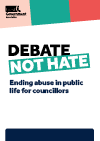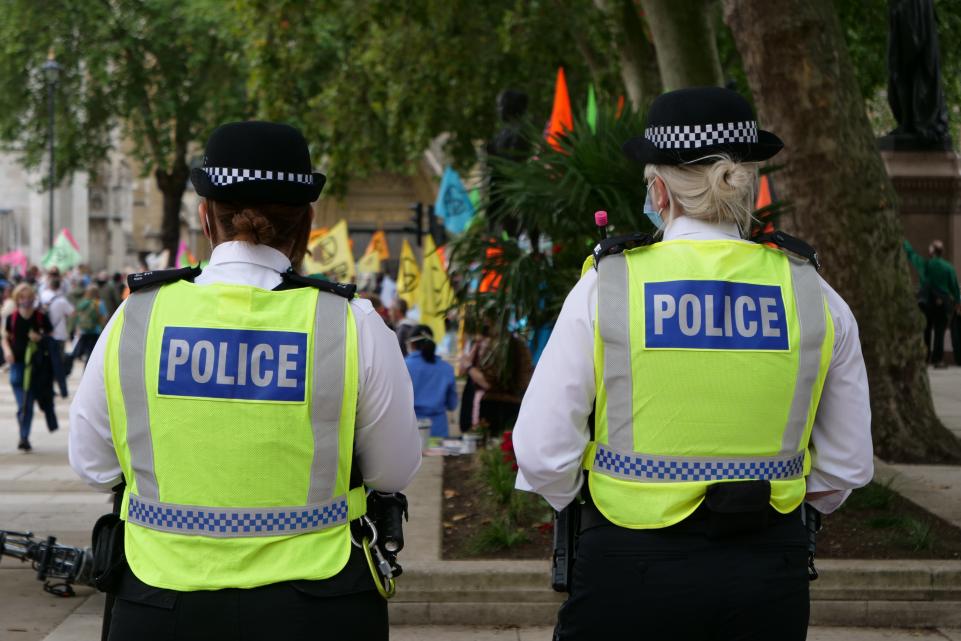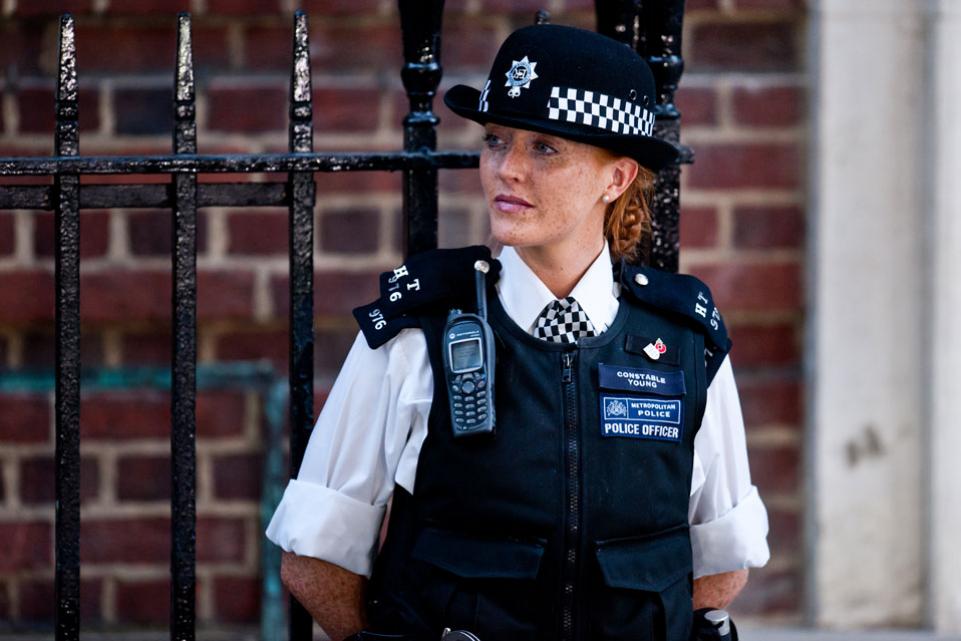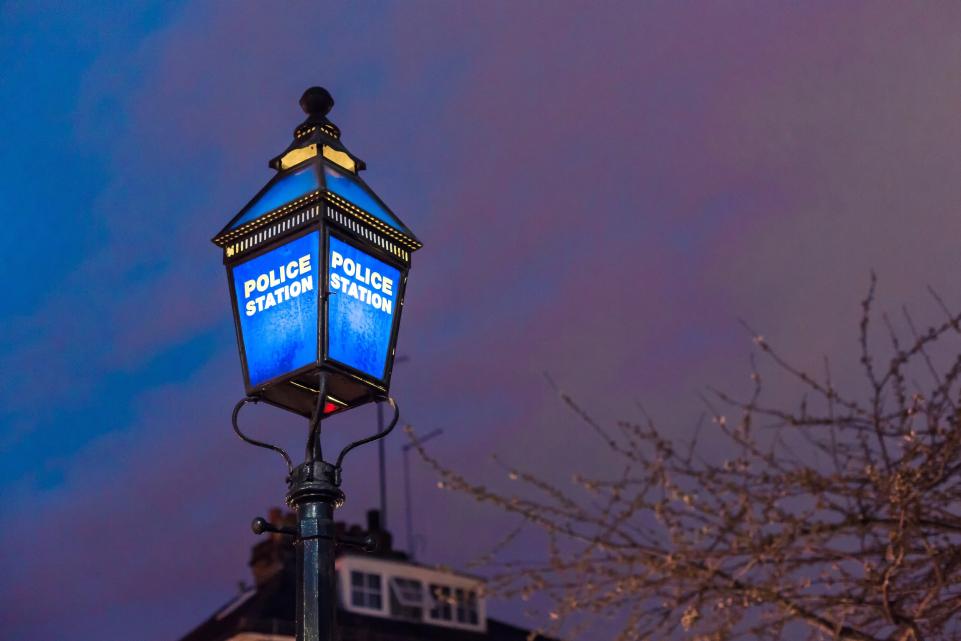
Executive summary
Serving in public office is both a privilege and a responsibility and our Debate Not Hate campaign is working to challenge the abuse local politicians face. However, there is a growing issue of abuse and intimidation in public and political discourse that can have a negative impact on councillors, their families and local democracy. This is why the LGA commissioned Riber Consultants to work with councils and relevant partners to consider the best approaches to supporting councillors to prevent and manage abuse linked to their elected role. Through the project, researchers identified key challenges to supporting councillors with these issues, principles for councils to consider, and top tips and good practice case studies to help councils better support councillors prevent and handle abuse and intimidation.
Challenges
- Challenge 1: Councillors feel vulnerable to abuse and ill-equipped or supported to handle abuse, harassment, and intimidation. Councillors are informed of their risk but have limited knowledge of tools for effective conflict resolution and aftercare.
- Challenge 2: Lack of clear process around reporting instances of abuse, harassment and intimidation to the council. Councillors don't know who to turn to when an incident occurs. There is limited understanding about the role and help that supporting officers can provide.
- Challenge 3: There is uneven engagement and response from the police to abuse and harassment of councillors. Some police forces are sympathetic, some others are not or consider low-risk abuse as something insignificant. There is limited advice tailored for elected officers in local politics and in occasions, a lack of understanding of why they need special measures.
Principles for support agencies
Based on workshops and follow up interviews with council officers, we propose some guiding principles to help councils navigate these challenges:
2. Clarity of process and responsibility: Clearly define the process for raising concerns and assign responsible individuals within the council to provide support to councillors.
3. Relationships with local police: Proactively develop strong relationships with the police to enhance coordination and foster mutual understanding of abuse affecting councillors and the role of police in addressing it.
4. Tailored risk assessments: Consider individual councillors' needs and proactively identify risks through dynamic and periodic risk assessments.
5. Prioritise councillor wellbeing: Recognise and consider how your council can support councillor wellbeing and address the negative impacts of personal attacks and hurtful commentaries
Recommendations
For this project, researchers used the framework of agency, whereby councillors, councils, police and local agencies have specific powers, resources and spheres of influence that they can affect. Through this framing, they also identified barriers to addressing abuse and intimidation which originate outside this sphere. In brief these issues included the management of harmful content online, the capacity and expectation of the police to respond to abuse against elected members, and the normalisation of abuse leading to poor standards of political and public discourse.
In response to these challenges, the LGA has developed three recommendations for central government, regulators and police forces across England to consider.
- Recommendation 1: The Government and Ofcom should take steps to ensure that harmful and abusive behaviour does not continue unrestricted online, including developing clear guidance for social media and other online service providers on their obligations to mitigate the risks of online abuse and how this may be best achieved; and that the experience of elected members is considered in any new Ofcom guidance mandated by the Online Safety Bill.
- Recommendation 2: The Government should work with the police to set out clear and consistent guidance on the role of policing in addressing abuse, intimidation and harassment of elected members. This should include expert capacity to monitor crime associated with elected members and act as a single point of contact for both councils and councillors.
- Recommendation 3: The Government should widen the scope of the Defending Democracy Programme to explicitly include the safety, security and wellbeing of locally elected politicians, rather than focusing solely on national politicians and foreign interference.
Introduction and background
Abuse of elected members is unacceptable and there is evidence that these experiences are forcing good councillors out of local politics and deterring others from running for election.
In 2022, the LGA found that seven out of 10 councillors had experienced abuse from the public in the previous year. Further research by the LGA in 2022, reinforced concerns that abuse in public life and public discourse is becoming normalised and seriously impacting civic life and local democracy.
The LGA has been working for some time to build a better understanding of the issue of abuse and intimidation of elected members and what individuals, local organisations and national government can do to reverse this trend.This project is part of a series of projects looking at what can be done to prevent abuse and address it when it occurs and focuses on what local agencies including councils and police can do to prevent and address abuse perpetrated against councillors. Other resources in this series include the Debate Not Hate: The impact of abuse on local democracy report and the Councillor guide to handling abuse and intimidation.
Project background
The project is based on the premise that individuals and organisations have various spheres of influence within specific structures and different levels of autonomy and agency. Here agency refers to the capacity of individuals to act independently and make choices, while structure pertains to the broader social systems and institutions that shape individual behaviour and limit agency. There is an inherent tension between agency and structure as individual actions are influenced by and impacted by the structures in which they sit. This is particularly relevant to discussions about councillors as they occupy an unusual position, neither volunteer nor employee: they have both more agency by sitting slightly outside usual employment frameworks, but also benefit from fewer legal protections.
In this paradigm, there have been efforts to maximise on this agency and upskill councillors to manage their own environments, mitigate risks and build resilience. However, councillors only have the power and autonomy to impact their own actions. Beyond a councillor's circle of influence, other organisations in the local area may have the power, resources and, in some cases, the responsibility to respond to abuse, intimidation and threats aimed at locally elected members.
For example, councils alongside political parties provide the primary support mechanism for councillors locally, with officers acting as points of contact for day-to-day business and providing specialist advice and information. However, councils also have limited powers, resources, and their own specific sphere of influence. Only with the coordinated input from other statutory and non-statutory parties, such as the police, media providers, and social media providers can we hope to address abuse and intimidation against councillors and other elected members. Further still there are some issues that require national, social or systemic change and which local organisations cannot address in isolation.
Throughout this project and this report, the authors have used abuse, intimidation and public intimidation to refer to "words and/or behaviour intended or likely to block, influence or deter participation in public debate or causing alarm or distress which could lead to an individual wanting to withdraw from public life". This could include a range of behaviours, a summary of which is set out in Appendix A.
Project methodology
Through this project the LGA aimed to take a step beyond existing research evidencing the prevalence and severity of this issue and set out possible local and national mitigations and solutions to abuse against councillors. To support this aim, researchers engaged with a range of resources and individuals who supporting councillors, have experience of handling issues of abuse and intimidation more generally, or have lived experience of these issues.
This was delivered through two distinct research phases. The first phase was delivered through primary and secondary research and aimed to identify the challenges and barriers deterring councils, the police and other agencies providing better support to councillors. The second phase was delivered through primary research workshops and looked to generate and develop solutions to the identified barriers. This was supported by the expertise of a project steering group drawn from a range of organisations with a substantive interest in the project.
Phase 1: Challenges and barriers identification
Detailed methodology:
Ecosystem mapping and stakeholder interviews
The issue of harassment, abuse and intimidation is a global issue, affecting all societies to varying degrees across the globe. As such there are many organisations and individuals interested in this issue. The purpose of the ecosystem mapping was to understand what expert organisations exist primarily in the UK, but also across the whole, how they approach abuse and intimidation issue and how this could apply to the local government sector.
In the UK there is significant interest in the topic of harassment, abuse and intimidation has increased significantly in recent years. Many organisations focus on women's rights and violence against women in politics; few are directed at other underrepresented minority groups or at politicians more generally. We identified approximately 60 key stakeholders working on the topic (full list at Appendix C) and prioritised a selection for detailed interviews.
Using a semi-structured interview method, we conducted 20 in-depth interviews with stakeholders from a range of backgrounds, including the public sector, the police, legal, social media and third sector organisations. The interviews focus on advice for people in public life, interventions that work well, problems with implementation and what change is needed to address the issue of abuse against people in public life.
Literature review
To better understand what tailored support there is for councillors, we conducted a systematic search of documents offering support and guidelines published by a random selection of 50 councils. The aim was to identify public approaches to handling abuse and intimidation of elected people, including councillor support packages, guidance on personal safety, zero-tolerance policies and other relevant content. In one fifth of the councils, we were unable to identify support aimed at supporting councillors with abuse or intimidation or personal safety. However, this does not necessarily mean that councils do not have these resources available to councillors. In many councils reviewed there was comprehensive or supportive guidance. Good practice identified from this exercise has been incorporated into this report.
Focus groups
As part of this phase, we hosted two focus groups, one for councillors dealing with abuse and intimidation and one for council officers with a role supporting councillors. The aim was to identify the barriers and challenges to providing councillors with better support around abuse and intimidation from each perspective. The focus groups were similarly structured and explored key issues around prevention, support, responses, and aftercare. Fourteen councillors attended the councillor workshop and 11 officers from a range of specialisms attended the officer workshop. Attendees came from a diverse range of authority types with different political control across the variety of English regions.
Findings
Changing dynamics
Abuse and intimidation in public life have emerged as escalating concerns over the past few decades. According to a study by Collignon and Rudig (2020), in 2019, 49 per cent of parliamentary candidates reported experiencing some form of harassment, abuse, or intimidation during their campaigns. This represents an 11-percentage point increase compared to 2017. Some officers reported that they felt that rising abuse levels in public discourse could be a result of anti-politics sentiment and proliferation of conspiracy theories online, which sometimes present as unfounded allegations of bias and corruption, and other abusive behaviours.
However, this change has been gradual, is not well evidenced in local government and has not always presented in the same way in different places creating a variability of responses linked to differential experiences. For example, an increase in support provided by councils has frequently been tied to severe national incidents or localised threats. In regions where such issues have not been prevalent or high profile, councils and other agencies may not have kept pace with increasing risks associated with the role of elected members.
Council officers and councillors have reported that abuse, intimidation, and harassment faced by elected members can have a detrimental impact on democratic representation, particularly where underrepresented groups in local and national politics receive higher volumes and more aggressive forms of abuse. For example, research analysing the effects of abuse on women's campaign strategies revealed a damaging link where women who experience intimidation tend to moderate their campaigning strategies and see their chances of electoral success undermined (Collignon and Rüdig, 2021).
Criminal thresholds and the legal framework
Councillors are elected officials and therefore are open to wider public scrutiny and criticism than officers and private citizens. This can make it challenging to identify the point when legitimate criticism becomes abuse, harassment and intimidation.
Serious incidents, such as physical assaults and credible threats to life and limb, will clearly meet the threshold for police intervention. These events will general fit neatly into the existing legal framework, which primarily concentrates on individual cases that involve a solitary victim and a lone perpetrator. It is understood that the risk of physical violence towards councillors is low in the England and most incidents may not constitute an immediate emergency but may nevertheless be criminal. Serious crimes like hate crime, stalking, and harassment have robust definitions, charging thresholds and legal consequences. However, many councillors have reported that they feel the threshold for police to record and investigate incidents against them is higher than ordinary citizens, because of their elected role.
While the law is relatively clear for some crimes, the same cannot be said for more frequent yet equally damaging forms of abuse, as online abuse and misinformation. The current legal framework inadequately addresses the cumulative or escalating impact of such abuse, as well as cases involving multiple perpetrators. This lack of clarity and understanding creates a grey area, which has significant implications for establishing clear reporting thresholds to the police and leaves victims without the necessary support or options for redress.
Additionally, it is not against the law to be unpleasant and in the process of determining if abusive speech is criminal, police must balance several considerations, including freedom of expression and journalistic expression. Abuse may not meet this threshold and yet still have a profoundly negatively impact on councillors and their families, particularly if it is repeated. Here it is also imperative to consider what additional vulnerabilities or aggravating factors there may be. For example, this is evidence that some groups with protected characteristics may receive higher volumes and more vitriolic abuse, particularly racist, homophobic and misogynistic abuse. Police should consider this in their assessment of risk and impact.
Capacity and awareness of the relevant agencies
Local agencies such as the council, the police and political parties all have a role in supporting councillors to ensure their safety and protect them as integral to the local democratic system. However, there are capacity issues across the whole of the public sector and there isn't consistent awareness of the issues of abuse against politicians across all areas. This can lead to councillors falling between the gaps between different organisations and feeling that all partners have abdicated responsibility for their safety.
This can play out in terms of prevention and response to abuse. Councils and police both hold valuable intelligence about their local areas and sharing this information allows for risks to be identified ahead of time and mitigated against before they become an issue. Capacity and structures to allow this information sharing to take place are therefore vital.
Police often face challenges due to limited resources and training. They must prioritise their resources and have many specific statutory duties that draw on their resources. This can hinder their ability to respond to lower-level incidents of harassment, abuse, and intimidation promptly or effectively. Operational separation between different police forces means there is significant variation across different regions, leading to inconsistent experiences for councillors who seek support and protection. Persistent issues revolve around the reporting process itself, including informal approaches, inconsistencies, and uncertainty regarding what will be investigated and what won't.
Lack of clear guidance on how to deal with vulnerable persons
Councillors engage with resident from all walks of life in their role, including vulnerable people seeking assistance. Councillors should always consider whether they are the most appropriate person to be supporting an individual and where it would be more appropriate to direct them to an officer at the council. In the case of vulnerable people, this could mean referring to the safeguarding team at the council who are trained and resources to provide specific support. Councillors are often reluctant to disengage with residents even if they are abusive, particularly if they consider the resident to be vulnerable – clear processes for referral and ensuring vulnerable people are appropriately supported through the council can help reassure councillors that they have done the best thing for the resident and disengage personally if necessary.
In extreme cases where an individual who is vulnerable due to mental health problems appears to be displaying fixated behaviour, such as harassment, stalking or threatening behaviour towards public figures the Fixated Threat Assessment Centre can help to assess the situation. The Centre is a joint police and mental health unit established in 2006 to assess and manage the risk to politicians, members of the British Royal Family and other public figures from obsessive individuals. It is unclear whether this support extends to local politicians. The Centre receives around 1,000 referrals a year, half of which are assessed as low risk and are referred to local health services.
Standards of political discourse
Politicians have a significant role in shaping public discourse, and their words and actions can have a powerful impact on society. As representatives of their local communities, councillors are dedicated to improving the lives of their residents through the development of better services and positive changes at the local level. Citizens have high expectations of their elected members, and councillors should strive to meet these expectations with integrity and professionalism. The council must also have a Code of Conduct to help councillors model best conduct, balance their behaviour, understand the expectations of their role and indicate the kind of conduct that could lead to action being taken against them. The LGA has developed a Model Councillor Code of Conduct, in association with key partners and after extensive consultation with the sector, as part of its work to support all tiers of local government to aspire to high standards of leadership and performance. At the same time, councillors deserve to be treated with respect by officers, fellow elected members, and the public at large.
Challenges
Based on the initial research phase, we developed three specific challenges that councils face in providing adequate support to their councillors with abuse and intimidation issues. These challenges then formed the basis of the phase two solution identification and development exercises.
Challenge 1: Councillors feel vulnerable to abuse and ill-equipped or supported to handle abuse, harassment, and intimidation
Due to the public nature of their role, councillors may be susceptible to verbal, psychological and physical abuse and intimidation from various sources, including members of the public. A central part of their role is engaging with local residents, and they often are involved with making difficult local decisions about local services. These decisions can be a catalyst for community disputes, personal disagreements and can escalate into heated confrontations. Councillors are generally aware of the risks associated with their role due to their experience campaigning and engaging with residents. However, without specific training and support, they may not possess the necessary skills to confidently identify risky situations, diffuse potentially volatile situations and de-escalate tensions, and ensure a positive outcome. Concerns about the risk of these challenging engagements can deter candidates and councillors from meeting and engaging with the residents they represent as much as they would wish.
Furthermore, councillors may also struggle to manage the aftermath of individual or ongoing incidents. For example, there may be practical concerns about the safety of their home, travel and council activities and they may need to make different arrangements to usual. This can be overwhelming, as can the need to engage with various agencies, such as the council, their political party and the police to handle serious abuse and put in place safety mitigations. The emotional impact, effort to seeking support and potentially counselling can be difficult if this support isn't readily available through the council or political party.
Challenge 2: Lack of clear process around reporting abuse, harassment and intimidation to the council results in councillors not knowing who to turn to when an incident occurs
Council officers play a vital role in supporting councillors with a range of needs associated with their elected role. This includes how councillors engage with the public on council matters and supporting councillors to deal with abuse, harassment, and intimidation they might experience. However, the council's role in protecting councillors' wellbeing is not set out in statute and therefore the thresholds and levels of support can be variable and are not well-understood by councillors. As a result, councillors may be unclear as to who they should contact in the council and what evidence they should collect of abuse. This is especially problematic when they experience low-level abuse that may not necessarily be a police matter but that requires to be logged and properly documented in case it escalates further.
Challenge 3: There is inconsistent engagement and response from the police to abuse and harassment of councillors
The diversity among police forces, including differences in resources and training, results in variable responses and levels of support provided to councillors based on geographical location. This discrepancy is influenced by differing understanding regarding the public role of councillors, leading to inconsistent engagement from the police and a lack of tailored safety advice. Consequently, we found inconsistencies in reporting procedures, which makes it difficult to develop effective interventions to prevent abuse, harassment, and intimidation of councillors. We also found that the differences in levels of engagement and support between police forces contribute to underreporting, leaving councillors feeling isolated and unable to fulfil their responsibilities effectively. To address this challenge, it is vital to foster positive relationships between the council and the police, underpinned by comprehensive training. Additionally, police forces need to establish a consistent understanding of when and how to intervene, ensuring that councillors receive the necessary support and protection they require.
Phase 2: Solution identification and development phase
During this phase of the research project, we used a bottom-up approach to identify best practice that already exists in councils and local police forces and develop new solutions to support councillors with abuse and intimidation from the public.
We used an iterative and agile methodology to identify and develop solutions to the three challenges identified in the first phase of the research at two workshops with council officers and other relevant experts. The approximately 60 attendees were drawn from a range of types of councils from across urban and rural areas in England. From these sessions, researchers developed a range of good practice case studies and suggested practice which councils and their local partners may find helpful.
Findings
The methodology employed in this project resulted in several key findings, which we would propose as guiding principles.
1. Zero-tolerance approach to abuse: establish and enforce a strict policy that sets clear expectations for interactions and promoting respectful debate.
Normalisation of abuse and intimidation in public and political discourse is a well-established growing issue with demonstrable negative impacts on local democracy. Democratic institutions may therefore need to respond to this rising issue and set expectations for interactions between the public and councillors, as many already do with staff.
Setting out a zero-tolerance approach to abuse could include a range of actions, such as ensuring that all relevant policies about managing negative interactions between the public and council staff also reflect councillor engagement with the public. Councils can also set expectations by highlighting respectful debate and engagement principles through digital and physical marketing materials aimed at those who engage regularly with staff and councillors.
Finally, there is evidence that many councillors consider their residents’ right to engage with their elected representative as sacrosanct and are reluctant to disengage, take officer advice or report incidents to the police even if the engagement is unhealthy, abusive or even threatening. In addition, councillors, unlike staff, are not obliged to comply with employment policies in the same way as employees. However, setting expectations and thresholds of what is acceptable communication with councillors from the outset may help them identify unacceptable behaviour and disengage from or refer abusive residents on to officers when appropriate.
2. Clarity of process and responsibility: Clearly define the process for raising concerns and assign responsible persons who are well equipped and located in the council to provide councillors with support.
Clarity of process was highlighted as a key challenge by councillors and officers alike. Councillors have consistently raised concerns about not knowing where to go for support in their councils. However, we found evidence that this is an issue that varies from place to place and in some areas, there is a clear and formalised process for raising concerns, either through a single point of contact (SPoC) individual or department.
This may be a symptom of the way abuse and intimidation of councillor presents locally. For example, we found that councils that had robust and embedded arrangements for supporting councillors with abuse and intimidation had often been galvanised into action by a local high-profile event or national event that have caused them to reflect on their local arrangements. Other areas were less prepared because they had historically not experienced these issues.
Setting out who is responsible for supporting councillors with abuse and intimidation within the functions of the council and ensuring they are appropriately skilled and resourced is critical to ensuring that appropriate support is embedded into the activities of the council. In addition, clearly setting out the kinds of support the council will provide, how and in what circumstances the support will be provided, and who councillors should go to day-to-day and in the event of an out-of-hours concern or emergency in clear processes and procedures can help to ensure officers know what to do consistently when councillors ask for support and help councillors feel well-supported in their role.
3. Relationships with local police: Proactively foster strong relationships with police to improve coordination and advance mutual understanding of abuse affecting councillors and the police role in addressing it.
Many councils have excellent relationships with their local police forces working together on a range of local issues, from anti-social behaviour to licensing. However, we hear often that police do not always engage with the issues of abuse and harassment that affect councillors. In particular, some councillors have expressed the belief that police did not take appropriate actions to record and investigate potential crimes against them because they were councillors.
We must be clear here that police forces must balance a range of considerations including the severity of the infraction and threat level, as well as capacity and available resources when responding to crime in their local area. In addition, through the process of this research we heard that police response is varied across different areas and that there are excellent examples of police taking action to deal with serious risk and incidents involving councillors.
Contributors to this research were clear that a strong relationship with the local police force was critical to ensuring that the police understood the specific experiences and challenges that elected members experience and to setting expectations with elected members as to when it is appropriate for police to get involved.
4. Tailored risk assessments: Consider the needs of individual councillors and proactively identify risks through dynamic and periodic risk assessments.
At the centre of this support should be the needs of members. Some council officers said that because they didn't have many reports of abuse and intimidation incidents, they had assumed it wasn't an issue for their members. However, once they began proactively asking members about their experiences, they found this wasn't the case. On the other hand, some councillors do not agree that abuse and intimidation is an issue for them personally or in their area and feel that support offered by officers is paternalistic and not a good use of public money. Officers should be alive to these views, but not assume that this feeling in one member reflects the views of others. Many councils have taken the approach of regularly surveying councillors on their training and support needs, this can help officers to tailor the support to the genuine needs of members and keep track of the changing issues in their local area.
As mentioned earlier, some councils had been prompted to put in place better support and protections by a particular incident or local tensions, but without sustained focus and attention to issues of councillor safety, good practice sometimes diminished with the threat. Some officers reflected that they recognised this challenge in their own area and were keen to reinvigorate their efforts. Other said they had recognised the role of the council in monitoring local tensions and ensuring these factors were played into a dynamic risk assessment of risks against staff and elected members alike. Council officers also have valuable information and a range of skills, such as health and safety, communications, community engagement and legal, that can help to identify and mitigate risks of everyday councillor activities, like engaging with the public and safely visiting locations in the local area
5. Prioritise councillor wellbeing: Recognise and consider how your council can support councillor wellbeing and address the negative impacts of personal attacks and hurtful commentaries.
Many officers commented that councillor wellbeing is a much bigger consideration now than ever before. The expectations of the public, ability to critique on social media and a tendency towards blame culture against public figures has resulted in high-profile local and national politicians being very exposed to hurtful public commentaries.
While it is absolutely right that councillors should be held to account for their actions as part of their role, many are now finding public abuse crossed the line into unnecessarily personal attacks and this can deter people from standing for election or re-election and seeking leadership positions. This is detrimental to democracy and at the extreme can lead to councillors feeling anxious and depressed. Beyond actions to support councillors manage their online engagement and protect them from real treats, many councils are now considering what more they can do to support councillor resilience and wellbeing. This can take a range of forms from informal buddying to counselling via employee assistance programmes.
Tops tips and case studies
The principles are designed to help councils to consider how best to provide support for their councillors in their local context. As part of both phases of the project, we collected ideas and good practice case studies to illustrate the range of activities councils are doing to support their members. We have divided these by theme of prevention and support, incident management and aftercare, but some examples will apply equally across all areas.
Prevention and support
Understanding needs and coordination
As mentioned in the principles, it's vital to understand the needs of individual councillors as they will not be homogenous across the country or even in the same council. Engaging well with members can also help with uptake of training and support, as their input can help ensure the offer will be most relevant to them.
There are several ways a council can achieve this engagement and a combination of approaches may be most appropriate. For example:
- establishing a small working group of councillors to identify gaps in support and share intelligence about common experiences
- doing regular surveys of members to understand what incidents affect them and what aspects they particularly struggle with
- creating open door or drop-in opportunities for individual councillors to speak to staff about concerns
- establishing a wellbeing or councillor safety champion(s) who can collect information from the range of members at the council and pass this information on to staff.
Many councils have been slowly increasing their action on these issues over the last few years, others have recently begun programmes of work to proactively consider their approach to council safety and wellbeing. Many have chosen to create an internal staff working group including the various departments that have relevant expertise. This could include officers such as:
- monitoring officer
- head of legal if not the monitoring officer
- democratic services
- heads of political group offices
- health and safety
- community safety
- communications
- community engagement
- human resources.
With expertise from a wide range of department innovative solutions can be brought forward. For example, one council use their Anti-Social Behaviour reporting system to record abuse against councillors. Police colleagues have access to this system which means that police can assess the reports, provide advice and note any patterns of abuse that might develop into harassment or other crimes. Leeds City Council use their existing assets, such as their 24-hour CCTV centre, to ensure councillors can call for assistance through lone worker devices when they are out in their communities visiting residents.
Hounslow Council is taking steps to address harassment affecting its elected members. Following the passing of a motion by the council is now working on setting up a cross-organisational working group with expert representatives from democratic services, legal, health and safety, and other relevant departments. The purpose of the group will be to use the various expertise to identify emerging issues and gaps in support and develop solutions that will help to prevent and deal with these issues when they arise. The group will also work towards creating a hub space on the intranet where members can access all the necessary information in one place, including access to counselling through the employee assistance scheme.
The council is also considering providing training on emotional intelligence and softer skills to help members pre-empt, navigate and deescalate tensions when challenging issues create passionate responses in the community. Furthermore, the council is encouraging and facilitating respectful and civil conversations about sensitive issues, such as misogyny, between its elected members.
The group will also consider what the council can do to prevent abuse against councillors and when the council should step in actively protect members. For example, it is sometimes appropriate for the council’s legal department to take over communications when correspondence is abusive and vexatious and to write an official letter informing the resident that the correspondence is no longer appropriate. This is an important step to explore all avenues before taking any further action.
Policies and guidance
Policies and guidance can support councillors to understand new aspects of their role, including elements of risk, and how the council can support them to navigate any issues they encounter. Councils may wish to consider if they need new policies to set what support is available or whether councillors can be incorporated into existing policies. Key policies could include:
- vexatious complainants' policies
- lone-worker policies and/or personal safety policies
- receipt of threat policies
- social media policies.
Where a policy isn't appropriate, guidance and good practice examples can support councillors to make informed decisions. The LGA has a Councillor guide to handling abuse and intimidation, which includes comprehensive social media guidance. However, some councils have developed their own guidance tailored to local circumstances:
- Blaby District Council guide - Personal Safety Guidance for Councillors
- Bradford Metropolitan District Council - Guide to Personal Safety for Councillors
Training
Councillors are usually provided with a lot of information and possibly training when they first become a councillor. However, it's important to repeat key training often to ensure councillors are well equipped throughout their term. Common options for training around abuse and intimidations include:
- personal safety and risk assessment
- social media training and digital citizenship
- general communications and healthy debate
- emotional intelligence
- conflict de-escalation
- code of conduct.
The LGA provides training and e-learning on some of these topics that are free for councillors in England. Councillors can access all learning options through the Civility in public life hub.
The council has developed a comprehensive social media toolkit that guides councillors on social media use. The toolkit includes a section that advises councillors on how to manage comments, protect accounts, and reduce the risk of harassment or abuse online. The council recently updated the toolkit in accordance with the civility and respect guide on social media, published by the civility and respect project in consultation with the Society of Local Council Clerks, National Association Local Councils, One Voice Wales and County Associations, ensuring that it is comprehensive and accessible to all councillors.
The toolkit is presented as part of the council’s training on social media which is made up of a theoretical and practical session. The first part of the training is conducted by the legal team and sets out how to communicate and use social media positively and in line with the council's code of conduct. The following practical sessions are conducted by the communications team and cover how to set up and use social media accounts and keep them technically safe.
The council's communication team engage with social media providers when they are aware of offensive posts and request their removal when necessary. This approach helps the council to strike the balance between promoting a safe and respectful online environment for councillors and residents alike.
Technology
Some councils are now providing a range of technological solutions to councillors to mitigate against safety risks associated with their councillor role and to help handle some lower-level abuse.
Some examples of useful technological solutions:
- Councillors have been provided with personal safety alarms, panic alarms or apps on their phone through which they can silently call for assistance. There are a range of options available for this and in some areas mobile options will not function due to poor signal.
- Some councils will provide councillors with a separate phone for council work, allowing them to keep their personal and council numbers separate. This can help councillor to disconnect and set time boundaries when they will respond to council business. Similarly, councillors can use a dual sim to have two phone numbers routed to one phone. This allows the convenience of carrying only one phone, but also allows the council to disable one number when they do not want to receive calls and to filter incoming calls depending on which number is being used.
- Profanity filters are now commonly available. Councils could support councillors to set profanity filters on their council email addresses. However, careful consideration should be given to what happens to the blocked emails. Blocked emails could contain a threat to life, and it's therefore important that someone checks the content of the email.
Councillors engage with residents in a variety of ways and occasionally this might mean hosting online, rather than in-person, ward surgeries. If there are any concerns about threats or abuse against a councillor, virtual meetings can help them to control their environment more easily, while also fulfilling their democratic functions. Providing access to zoom accounts and additional strategies like asking participants to pre-register, monitoring or disabling the chat function and setting expectations about conduct.
Risk assessment and mitigation
Risk assessments are a key part of a preventative approach to councillor safety and something that council officers will be very familiar with in relation to risk assessing council events and council buildings. However, as part of their role, councillors will often hold ward surgeries, meet people in public places, travel to and from meetings and may even visit resident's homes in their role as a councillor. It's important that these situations are also risk assessed and mitigations put in place to make these interactions as safe as possible. There are several approaches to this, which depend on the available resources and the level of risk associated with the individual councillor.
Risk assessment options range from simply supporting councillors to make their own risk assessments of their activities through templates and light touch guidance. However, if the level of risk is higher, it may be necessary to support councillors more directly by offering officer support to make risk assessment and mitigation proposals for a range of activities and locations, including the councillor's home.
In addition, officers may be able to provide information to councillors to help them assess risk related to individuals, rather than locations. For example, if a councillor is planning to visit a resident they haven't engaged with before, they may wish to check that the person isn't flagged on the councils potentially violent persons register. Council officers may be able to provide advice as to whether visiting is advised or not, without providing specific information about the individual. Some police forces have also provided this kind of check previously and can give advice on whether to visit or not, again without providing personal or confidential information.
If the threat is deemed to be viable, then the police may also be able to provide home security and other safety advice, such as better lighting, ring doorbells, separating post-boxes from the main home and may flag a home address for priority response by the police.
Engaging with the police
Information sharing between the police and councils is key for various reasons. However, councillor safety is one among many priorities that police must balance against available capacity, and that's why it is key to proactively engage with the police and create environments where information can be shared in both directions and where potential issues can be flagged and addressed early. Contributors to this project suggested several ways this council be achieved.
- Having a senior police officer responsible for liaising with the council as an organisation was key for intelligence sharing, particularly around identifying increasing community tensions or trigger issues that the council or specific councillors might be involved with. Having this connection could also help progress investigations where the officers dealing lacked the expertise to factors in the added risk dimensions associated with being an elected councillor.
- Creating strong connections between neighbourhood policing teams and their local councils and councillors helped provide soft support at events where the council didn't have a formal presence. This could include local neighbourhood patrols including ward surgery location on surgery days and flagging councillors home addresses for urgent response if a risk had been identified.
- Having police attend candidate election briefings and councillor induction events can help to improve mutual understanding of each other's roles and what councillors can reasonably expect police to be involved with.
Kirklees Council took a practical approach to dealing with abuse and intimidation of candidates and councillors focusing on engaging more with the police on these issues. First, the council established a specific named point of contact within the local police force. Ongoing contact with this officer meant they developed a good understand needs and concerns of councillors. This helps to streamline the reporting process for councillors who experience harassment or abuse.
Second, they now involve discussion of the role of the police in members' induction. This allows the council to proactively approach the issue of harassment and intimidation by setting out a clear understanding of the enforcement role of police and the role of the council in the early induction of new councillors. This can help to ensure that councillors are aware of the support and resources available to them and where to access support if they experience any form of abuse or harassment.
Some lessons learned include; not all councillor and candidates will experience abuse and intimidation, but it's key for them to be aware of these issues so they can be properly prepared to manage them if they do happen. Engaging with the police regularly can help to develop a long-term sustainable relationship.
Managing councillor information
Councillors are representatives of their local communities and engage regularly with their residents. In the past it was usual for councillors to have their home address published on the ballot paper when they were running for election, on the council website and on the register of pecuniary interests. Since 2019 councillors have had the option to put their local authority areas on their ballot paper rather than their full address. However, they may still then have to declare the address on the public register of the interests and some councils still put home addresses up on the website, although this is becoming increasingly rare.
Councillors may apply to their monitoring officer for a dispensation not to declare their full address if they believe it is a sensitive interest where disclosing the interest could lead to the member, or a person connected to them, being subject to violence or intimidation. However, the threshold for this is not set out in guidance or in law, although a letter to council leaders from the then Minister for Local Government, Rishi Sunak MP, encouraged monitoring officers to "look sympathetically at such requests where there are legitimate concerns of abuse or intimidation".
Some candidates and councillors prefer to have their information available to the public to ensure transparency and accessibility. However, increasingly councillors are reporting that had they known the abuse they would experience they would have requested to withhold that information. Being open throughout the election process about the options and potential risks of publishing personal information may help councillors make informed decisions.
Setting expectations
Many councillors find it very difficult to disengage from residents, even if the communication has become abuse and continued engagement is unlikely to have a positive outcome for the resident or the councillor. Proactive actions to set out how councillors will engage with their residents can help to set expectations before the interaction begins and provides councillors with a clear policy and guidelines as to when they should disengage. This could be practical information in the first instance, for example, setting out response times and opening hours and indicating that casework should be sent via email. However, councillors can extend this principle to specific that abuse will not be tolerated.
The LGA published Digital citizenship guidance for councillors which includes infographics setting out the Rules of engagement. These rules set out clearly what was welcome, including debate and disagreement, but that abuse, threats, false information, and discriminatory language or statements would result in a cessation in engagement and being blocked if on social media. These rules were intended for online communication, but could be amended for other medium of communication, including in person engagement.
This approach has been adopted by other organisations that engage with the public. For example, Transport for London often engages with residents and believes in setting expectations as to how a meeting should be conducted ahead of time. To support the aim of having a mutually conducive meeting, they use a Terms of Attendance document to set out their expectations for the meeting, which the chair of the meeting must acknowledge and agree to adhere to This agreement means that if a meeting becomes abusive or inappropriate, TfL staff reserve the right to terminate the meeting. In a council setting, template terms of attendance could support councillors to set expectations ahead of ward surgeries or home visitors. In addition, template responses explaining that abusive communications will not be responded to and setting out corrective actions would help councillors reset communications and enforce rules of engagement.
Managing public narratives
Research by the LGA found that sometimes there are particular trigger events or decisions that are a catalyst for abuse, harassment and intimidation. Sometimes these are unexpected, but often the council is aware of that a decision is contentious before it is made. This prior knowledge presents an opportunity to provide proactive support to councillors to help them manage any negative impacts that arise following an event or decision. Communications officers are responsible for responding to requests for information from the public and the media and will often prepare for enquiries following significant council or local events.
Providing this advanced warning of potentially contentious issues and providing factual briefing to councillors can help them to weather social media storms and ensure that information does not become distorted. Advice about how to suspend comments, report abuse on social media, and tips for responding in a productive and safe way can also help councillors online.
Behaviour and conduct
Councillors are leaders of their local community and engage with other elected members to make decisions that impact their residents. In doing so they must act in accordance with the Seven principles of public life, often called the "Nolan principles":
- selflessness
- integrity
- objectivity
- accountability
- openness
- honesty
- leadership.
Under the heading of leadership, the principles are clear that holders of public office should treat others with respect and challenge poor behaviour wherever it occurs.
Councils are required to have a councillor code of conduct in place based on these principles and this should be the basis for instructing councillors on the standards and conduct expected of them. Councils should try to ensure that the code of conduct and any associated training support their councillors to display the best behaviours and encourages high standards of respectful debate and conduct. This could mean regular training on the code, reviewing the code to ensure it is fit for purpose, and developing a shared understand across political groups and members of the value of high standards. In addition, councils can consider tools to reduce reliance on the code of conduct, for example local resolutions protocols that are widely used in Welsh councils.
Councillors may also benefit from resources aimed at generally raising the quality of online communication and reducing abuse and misinformation. This could include councillors committing to using good digital citizenship techniques as set out in the LGA Digital citizenship guide.
Incident management
Support and reporting mechanisms
Council officers support councillors with many aspects of their role, guiding them through the processes of the council, providing support with case work and information the councillor requires. However, when it comes to reporting abuse and intimidation councillors need to be clear where to go to find information and who they should contact and in what circumstances.
Council should try to ensure that all the information councillors need is in one place and easily accessible. For example, the London Borough of Hounslow is developing a 'one-stop-shop' space on the council intranet where councillors will be able to access all the relevant information.
Many councils have a single point of contact for councillors, although the responsible individual or function in the council varies from council to council. This variation is to be expected, but the crucial point is that councillors know who to go to and that the function available is able to cope with workday and out-of-hours issues.
This can be a lot of expectation to place on one individual, and some officers suggested having a team as the SPoC with a responsible senior manager balanced the need for 24-hour support with clarity of responsibility.
Councils should also establish a clear and simple method for reporting incidents which allows easy analysis so that trends and repeated harassment can be identified. Again councils have a range of ways to manage this:
- one council uses their Anti-Social Behaviour system to record abuse against councillors
- others use simple forms and shareable documents on SharePoint
- others use other case management systems to record data.
Triage
It can be challenging to determine when criticism crosses the line into abuse and when councillors should report this to the council or to the police. They should be encouraged to report if they are in any doubt and obviously if they are in fear for their safety, they should call 999.
Councils should be prepared and have plans in place to deal with the receipt of threats so that officers can respond quicky and reassure the councillor. This could include basic actions, like being absolutely clear where and how councillors can report a threat, securing as much information as possible about the threat, informing the police, checking in with the individual involved, updating them regularly on what is going on, and being very clear about the role of the police as compared to that of the council.
For lower-level abuse, some councils have taken innovative approaches of using a committee to review abuse received by councillors and determining whether this has crossed the line and warrants an official response from the council. This removed the responsibility for determining thresholds from the individual experiencing the abuse and creates a level of consistency as to how abuse against councillors is dealt with.
Informal and legal actions
If a resident or other individual has crossed the line from legitimate criticism to abuse in a way that may not be criminal but is harmful to the councillor and which the council agrees warrants a response, there are some actions a council could take:
- The council leader or monitoring officer could send a letter to the individual setting out why the behaviour is unacceptable and requesting that they desist from further abuse.
- The council could put in place a single point of contact for the individual where they would be asked not to contact the council again, but communicate with a senior officer instead.
- In multi-councillor wards, the other councillors might agree to take over communications with the individual, allowing the victim of the abuse to disengage.
In extreme circumstances, where an individual continues to abuse an individual, their actions could constitute a criminal offence such as harassment or stalking and a criminal or civil case could be pursued, and an injunction could be placed on an individual instructing them to desist. However, criminal cases must pass a high threshold for prosecution and civil cases are extremely expensive, may not be successful, and can have unintended consequences. For example, the extreme case of Robert Pickthall who took his own life rather than accepting a prison sentence for breaching an injunction which prevented him from harassing councillors and officers at Cheshire West and Chester Council (case law: Cheshire West and Chester Council v Pickthall).
Durham Council has a strong commitment to protecting councillors from abuse, harassment, and intimidation and takes threats against councillors very seriously. The council's approach to dealing with harassment or abuse of councillors is proportionate to the level of threat using the expertise of the council’s legal and health and safety teams to decide how to proceed. This is supported by engagement with the police as appropriate to address serious incidents and provide essential advice and support depending on the severity of the situation.
For example, the council’s Monitoring Officer, meets regularly with the Deputy chief constable. This provides an opportunity to flag concerns and share intelligence. In the meetings they discuss any issues related to councillor’s experiences of harassment or threats of violence, and the police provide advice and guidance. The police are very responsive to issues that need to be reported in between meetings. Councillors are encouraged to report all incidents of abuse, harassment and intimidation to Members Services even if it is considered to be minor or low level. All such incidents are logged internally and where appropriate with the police. This helps track incidents and identify patterns of behaviour which may pass the threshold for police action.
Member services in consultation with the health and safety team assess the level of threat using a predetermined process. Where the risk is low, the incidents will be logged and appropriate advice given to the councillor (e.g. how to amend social media settings/re-direct or block emails). In more serious cases, which do not meet the threshold for police action, the council will consider whether to take action e.g. writing to the individual and/or seeking an injunction. In serious of cases of abuse harassment and intimidation, the police will take appropriate action.
Where it is considered that an individual’s behaviour threatens the immediate safety of councillors or staff, a decision may be taken to place that individual on the Potentially Violent Persons Register. Such behaviour includes conscious, deliberate or malicious acts of violent, aggressive or abusive behaviour towards council employees or councillors. It is possible for those who interact with the public to check whether someone they are due to meet is on the register and what mitigations are in place.
Aftercare and resilience
Peer support
Councillors have a unique position as elected members and do not fit into the usual managerial structures of a council. However, following an incident they may want to speak to someone who understands their position, such as a buddy, a mentor or specific member who has taken responsibility for welfare issues. This works differently in each council, but key examples include:
- Wellbeing champion – this could be a senior member who has taken responsibility for the wellbeing of councillors across the council or there could be wellbeing champions in each political group catering to their own members.
- Wellbeing cafés –parish councils in Cornwall have set up wellbeing cafes designed to allow members to come together in an informal space to discuss concerns, share experiences and solutions.
- For independent councillors who sit outside formalised political parties, there can be an additional challenge. However, independent councillors may make informal arrangements with other councillors to provide valuable peer support improving wellbeing and reducing stressed caused by independent working.
- Finally, councillors struggling to find peer support within their authority, can request support through the four LGA Political Group Offices.
Formal support
Although peer support is an important aspect of aftercare and building resilience, there may also be a need for more formalised support from someone with specific skills, such as a mental health first aider or counsellor. Mental health first aiders are becoming more common and this may be helpful training for councillors and officers in political group offices. Some councils have also allowed councillors access to their employee assistance programmes so they have equal access to counselling support.
Conclusion – what barriers remain?
Councillors’ experiences of abuse and intimidation vary, and some councils may experience more issues that others. However, there is clear evidence that abuse of politicians is on the rise across the board and that issues can arise and escalate very quickly. Councils would therefore be prudent to anticipate issues that may occur in the future and prepare to respond to abuse from members of the public. Additionally, this variation of experience means that there is no ‘one-size-fits-all’ approach to follow, but the general principles we have set out in this report may help councils to consider the level of support their members require and how best to provide this support.
Councillors, political parties, councils and local police all have a role to play in preventing and dealing with abuse targeted against councillors. However, there is also a limit to their power, resources and responsibility to handle these issues and some things they will not be able to influence.
The behaviour of the public can be influenced and managed but cannot be entirely mitigated against. In addition, it is not against the law to be unpleasant or abusive and for the purposes of protecting freedom of speech the threshold for criminality is high. However, there are some environments where abusive speech and behaviour has the capacity to cause particular personal and democratic damage – notably online, particularly on social media. Cumulative derogatory and abusive comments, which are easily facilitated by online environments, can have a serious impact on individuals and their families, while online misinformation and disinformation can be impossible to contain and may in fact impact the integrity of local democracy itself.
Engagement with police and the variability of police response to abuse against councillors and others in public life was a common theme in this research. Most feedback indicated that the police can be relied on to deal with serious threats to life and violent crime. This is reassuring, but the perception that less serious or immediately threatening crimes are taken much less seriously and in many cases are not addressed at all is pervasive.
The role of the police is to maintain law and order in local areas by protected the public and their property, including preventing crime and reducing the fear of crime. However, we have heard from many sources that the police are not resourced to deal with all crime and this manifests as reports of crimes not being recorded or investigated. This is aggravated by a lack of understanding of the role that councillors fulfil and the associated risks. Within this research we have set of various options for improving relationships with the police and improve the mutual understanding of the role of councillors and the police, however, more is needed to improve consistency and outcomes.
Finally, councillors are a central part of our democratic system. Residents have high expectations of councillors and entrust them to make decisions that affect their lives. It is therefore vital that councillors are held accountable for their actions and display appropriate behaviours for leaders and representatives of their council. The vast majority of councillors strive to uphold these standards, understanding the individual and collective responsibility associated with their role. However, this is not universally the case. It is important that political parties and their members set the example of proper conduct and councils have the appropriate processes and powers to deal with breaches of the code of conduct.
Case studies
Appendix A: Definitions of abuse
Public intimidation is defined by the LGA as “words and/or behaviour intended or likely to block, influence or deter participation in public debate or causing alarm or distress which could lead to an individual wanting to withdraw from public life”.
This includes actions of abuse, harassment and intimidation such as:
- verbal abuse
- physical attacks
- being stalked, followed, or loitered around
- threats of harm
- distribution of misinformation
- character assassination
- inappropriate emails, letters, phone calls and communications on social media
- sexual harassment or sexual assault
- Any other threatening behaviours, including malicious communications such as poison pen letters, indecent or grossly offensive emails or graphic pictures that aim to cause distress or anxiety.
Appendix B: Guidance and other documents
- Blaby District Council guide - Personal Safety Guidance for Councillors
- Bradford Metropolitan District Council - Guide to Personal Safety for Councillors
- The True Vision website was created because there was an issue with underreporting of hate crime that was difficult to quantify. This website makes the reporting of hate crime easier. The website also has a special section on hate crime during an election. There is accompanying HRC guidance on hate crime during the election period.
- The Suzy Lamplugh Trust ran the Staying Safe on the Doorstep Campaign for the parliamentary candidates and their staff during the 2015 General Election campaign. The advice is still relevant to any volunteers, staff or candidates of local elections who are seeking who seek to canvass support by knocking on doors. The advice card with safety tips and information is available in their website at no cost.
Appendix C: List of key stakeholders identified in ecosystem mapping
- CfGS
- Crash Override Network
- Crimestoppers
- Digital-Trust
- Elect Her
- Equality Advisory Support Service
- Fix the Glitch
- Get Safe Online
- Hope Not Hate
- Hourglass
- Jo Cox Foundation
- Paladin – National Stalking Advocacy Service
- Protection Against Stalking
- Samaritans
- SARSAS
- Stop Hate UK
- SupportLine
- the National Association of Local Councils (NALC)
- The Suzy Lamplugh Trust
- Unison
- Victim Support
- Victims Choice
- CACH
- Cybersmile
- NPCC - National Police Chiefs Council
- True Vision, Hate Crime Independent Advisory Group
- Electoral Commission
- Weightmans
- SOLACE
- LLG
- COSLA/Scottish Police
- Social Media
- Illegal Harms, Hate & Terrorism at Ofcom
- Facebook /Meta
- Association of Police and Crime Commissioners
- Political parties / GO (inc. Individuals who signed Debate Not Hate public statement)
- the Committee on Standards in Public Life (CSPL)
- Association of Labour Councillors
- Compassion in Politics
- the Association of Democratic Services Officers
- the Association of Electoral Administrators
- Employment Related Services Association
- Lawyers in Local Government
- National Hate Crime Awareness Week
- Amnesty International
- Digital Freedom Fund
- eSafety Commissioner
- NDI (National Democratic Institute)
- NetSafe
- SPARC
- THE CYBERSMILE FOUNDATION












